- Center on Health Equity & Access
- Clinical
- Health Care Cost
- Health Care Delivery
- Insurance
- Policy
- Technology
- Value-Based Care
ACE Inhibitor or ARB Treatment Among Patients With Diabetes and Chronic Kidney Disease
ABSTRACT
OBJECTIVES: Many patients with type 2 diabetes (T2D) and chronic kidney disease (CKD) experience a delay in treatment or fail to initiate treatment with guideline-recommended angiotensin-converting enzyme inhibitors (ACEis) or angiotensin receptor blockers (ARBs) after CKD diagnosis. This study aimed to describe treatment patterns and treatment initiation after initial CKD diagnosis among patients with T2D.
STUDY DESIGN: Retrospective analysis using data from the Optum Clinformatics Data Mart administrative claims database (January 2014-September 2018).
METHODS: Adult patients with T2D entered the cohort if they met the criteria for CKD, defined as 2 laboratory test results 90 to 365 days apart (January 2014-September 2017) indicating CKD. Included were patients with no prior use of ACEis or ARBs or evidence of kidney disease in the 365 days prior to cohort entry (baseline). Patients were followed for a maximum of 365 days and were censored on death, disenrollment, or end of data. Patient demographics, comorbidities, and medication use were assessed at baseline, and treatments were assessed over a 1-year followup period. Multivariate logistic regression was used to identify factors associated with ACEi or ARB initiation.
RESULTS: Among 15,400 eligible patients without prior ACEi or ARB treatment, only 17% initiated such therapy within a year after meeting CKD criteria. Patients who were White, resided in the northeastern United States, had more comorbidities, had less advanced albuminuria, or used sodium-glucose cotransporter 2 inhibitors were less likely to initiate treatment.
CONCLUSIONS: A large proportion of patients with T2D meeting criteria for CKD do not initiate the recommended therapy within 1 year of CKD diagnosis, highlighting a need for new therapies that can slow the progression of CKD.
Am J Manag Care. 2021;27:S360-S368. https://doi.org/10.37765/ajmc.2021.88806
For author information and disclosures, see end of text.
Introduction
Type 2 diabetes (T2D) is a highly prevalent disease, with approximately 23.1 million individuals receiving a diagnosis in the United States in 2017.1 Chronic kidney disease (CKD), a serious complication of T2D that affects between 25% and 40% of all patients with T2D, is characterized by compromised renal function or renal injury, as evidenced by the presence of albuminuria, due to persistent uncontrolled hyperglycemia and hypertension.2 CKD in T2D is associated with elevated rates of cardiovascular disease and is partially responsible for the elevated mortality risk in these patients.3,4 Prolonged, unmanaged CKD often leads to end-stage kidney disease, requiring dialysis or renal transplantation.5 In 2015, the costs associated with kidney disease in the United States were nearly $34 billion.6
No current therapy has been shown to reverse CKD damage in patients with T2D, but existing treatments aim to slow CKD progression. Current American Diabetes Association treatment guidelines recommend controlling blood pressure with antihypertensive drugs to slow or halt CKD progression,7 including angiotensin-converting enzyme inhibitors (ACEis) and angiotensin receptor blockers (ARBs).8,9 Recent studies report that mineralocorticoid receptor antagonists (MRAs) may also have a role in reducing albuminuria in patients with diabetes and CKD.10 These antihypertensive therapies also target the renin-angiotensin-aldosterone system to lower blood pressure and preserve kidney function.11-14 Antidiabetic treatment with sodium-glucose cotransporter 2 inhibitors (SGLT2is) has also been shown to exhibit renoprotective effects, in addition to controlling blood glucose levels.15
Despite established clinical practice guidelines, data on timing of initiation of antihypertensive treatment for CKD in T2D and adherence to guideline recommendations in real-world clinical practice are limited.16 This study aimed to describe ACEi or ARB utilization rates and identify factors associated with treatment initiation among patients with T2D and newly identified CKD in a US-based administrative claims database representative of the commercially insured US population.
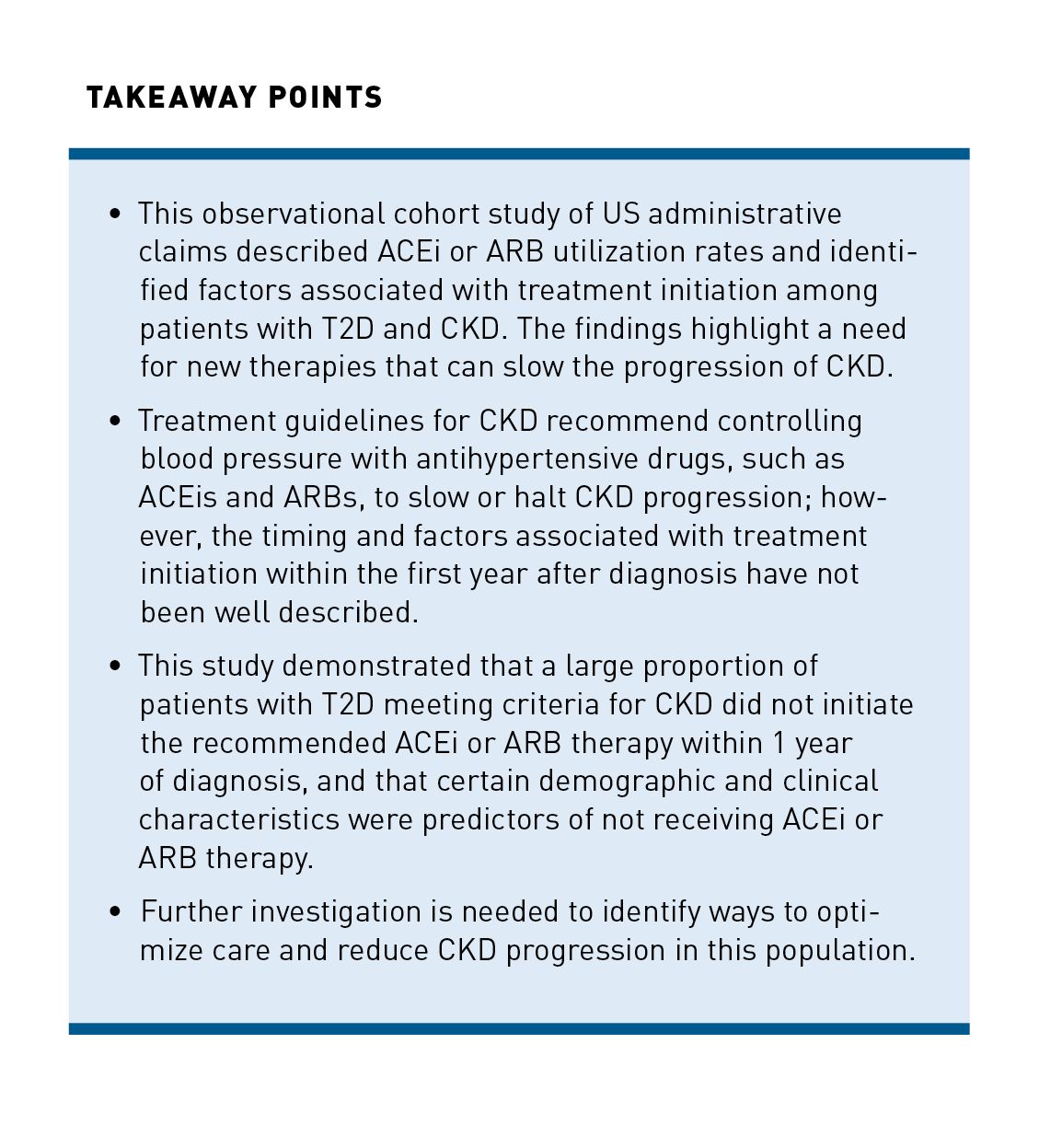
Methods
Data Source
This observational cohort study used deidentified administrative claims data from Optum Clinformatics Data Mart (January 2014-September 2018), which contains longitudinal outpatient and inpatient diagnoses and procedures, outpatient prescription dispensing data, and laboratory data for patients enrolled in commercial health plans and Medicare Advantage.17 This research was exempt from Health and Human Services requirements for institutional review board approval and informed consent (45CFR46.104[d]).
Study Population and Design
Adult patients with T2D were included upon meeting criteria for CKD, defined as at least 2 clinical laboratory results 90 to 365 days apart (January 2014-September 2017) indicating a reduced estimated glomerular filtration rate (eGFR) (<60 mL/min/1.73 m2 ) or least 2 test results 90 to 365 days apart demonstrating an elevated urinary albumin to creatinine ratio (UACR) (≥30 mg/g). Index date was defined as the second clinical laboratory test result indicating CKD 90 to 365 days after the first. Patients were required to have no evidence of ACEi or ARB use or renal disease in the baseline period, defined as the 365 days prior to the index date. Patient demographics, comorbidities, and medication use were assessed during the baseline period. Treatment was recorded over the 1-year follow-up period, beginning on the index date and ending on the earliest occurrence of death, disenrollment, or end of data. Figure 1 includes additional detail regarding inclusion and exclusion criteria and the study design.
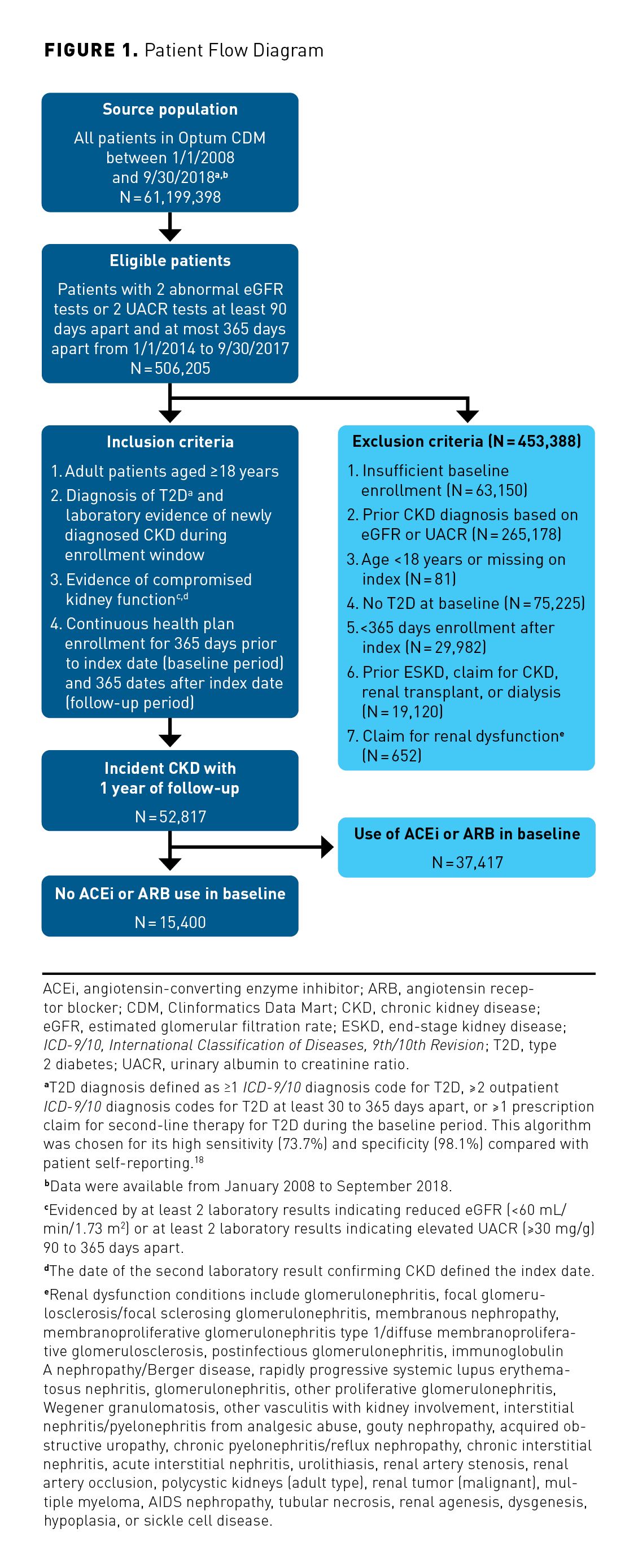
Exposures and Outcomes
The outcome of interest was ACEi or ARB initiation, defined as a pharmacy claim for an ACEi or an ARB during the follow-up period (Table 1). Patients’ demographics, including age, sex, race/ethnicity, and US region, and CKD stage-defining variables assessed on the index date were reported. Prevalence of baseline comorbidities and medication use were measured during the baseline period. Provider specialty on the index date was described. A full list of variables is provided in eAppendix Table 1 (eAppendices available at ajmc.com). Treatment patterns with ACEis or ARBs during the first year after meeting CKD criteria were described, including the number and proportion of patients initiating treatment and treatment duration.

Statistical Analysis
Logistic regression was used to identify baseline characteristics and medication use associated with ACEi or ARB treatment initiation. Bivariate associations are presented for all covariates included in the model. A backward selection model was used for the selection of predictors in the final model. The Akaike information criterion (a method used in model selection that estimates the relative quality of statistical models relative to each other) was used to evaluate model performance.19 Effect estimates were reported as odds ratios and 95% confidence intervals. Two-sided P values with an α = .05 were also reported. No imputation of missing values was performed. The extent of missingness was reported in descriptive tables.
A sensitivity analysis was conducted to evaluate the impact of known contraindications for ACEis or ARBs at treatment initiation. Analyses were stratified by timing of ACEi or ARB initiation. The following variables were considered separately if they occurred in the 365 days before the index date or at any time prior to the index date: ACEi or ARB toxicity, angioedema, aortic stenosis, hyperkalemia, hypotension, shock, and renal disease/dysfunction. All statistical analyses were performed using the Aetion Evidence Platform version 3.7.20
Results
Patient Characteristics
Of the 52,817 patients with incident CKD in T2D with 1 year of follow-up, 70.8% (n=37,417) were using an ACEi or ARB at baseline. Of the remaining 15,400 patients, 2641 (17%) initiated therapy within 1 year of cohort entry (Figure 1). Table 1 details the baseline characteristics of the study population. Patients initiating therapy were, on average, slightly younger than those who did not initiate therapy (70 vs 74 years, respectively) and had earlier stages of CKD based on eGFR laboratory results. Approximately 80% of patients in both groups had preexisting hypertension.
Treatment Patterns
Compared with initiates, patients who did not begin therapy with ACEis or ARBs had a lower prevalence of first- and second-line antidiabetic medication use (Figure 2A). Common second-line treatments were sulfonylurea, dipeptidyl-peptidase-4 inhibitors, and basal insulin (Figure 2B). In addition, baseline medication use in this population reflected the management of multiple cardiovascular-related comorbidities, with frequent use of 3-hydroxy-3-methylglutaryl coenzyme A reductase inhibitors, β-blockers, calcium channel blockers, thiazide diuretics, and loop diuretics (Figure 2C). After initiation of ACEis or ARBs, 1369 (55%) patients discontinued treatment within the first year of follow-up, with an average time to discontinuation of 5 months.
Characteristics Associated With ACEi or ARB Initiation
In the bivariate assessment, attributes associated with lower likelihood of treatment initiation included male sex, White race, Northeast region, more advanced CKD (eGFR stages 2-5), UACR category A1, and MRA use (Table 2). Characteristics associated with higher likelihood of ACEi or ARB initiation included obesity, use of antidiabetic medications, and the use of most cardiovascular agents except for MRAs (eAppendix Table 2). Key predictors of ACEi or ARB treatment initiation in the final model are presented in Table 3. Characteristics associated with lower likelihood of treatment initiation included White race, Northeast region, presence of atrial fibrillation, depression, pain disorders, coronary artery disease, and MRA use. Those meeting criteria for resistant hypertension and users of SGLT2is were 45% and 63% less likely to initiate therapy, respectively. Users of β-blockers, centrally acting antihypertensives, and statins were more likely to initiate ACEis or ARBs.
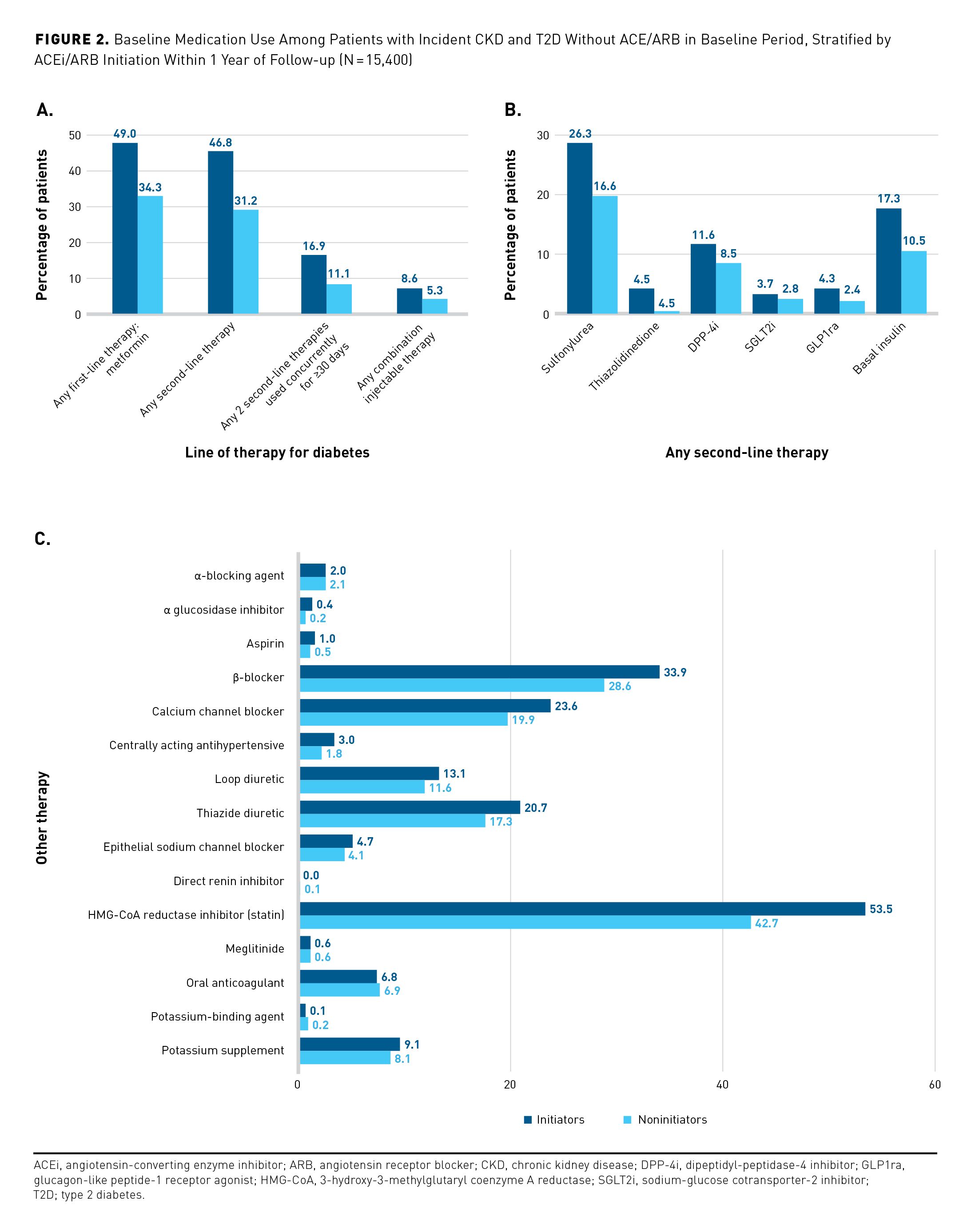
Contraindications
Among patients who met criteria for CKD in T2D and had no baseline ACEi or ARB use, the presence of potential ACEi or ARB contraindications did not differ by whether patients initiated therapy with ACEis or ARBs within 1 year of follow-up (eAppendix Table 3). At least 1 contraindication was observed among approximately 20% of patients whether they received ACEis or ARBs or not, in 6% of patients with evidence of hyperkalemia prior to index (by diagnosis or laboratory test result), and in less than 10% of patients with evidence of hypotension. These findings suggest that failure to initiate treatment with an ACEi or ARB within 1 year may not be attributed to a previous contraindication alone.
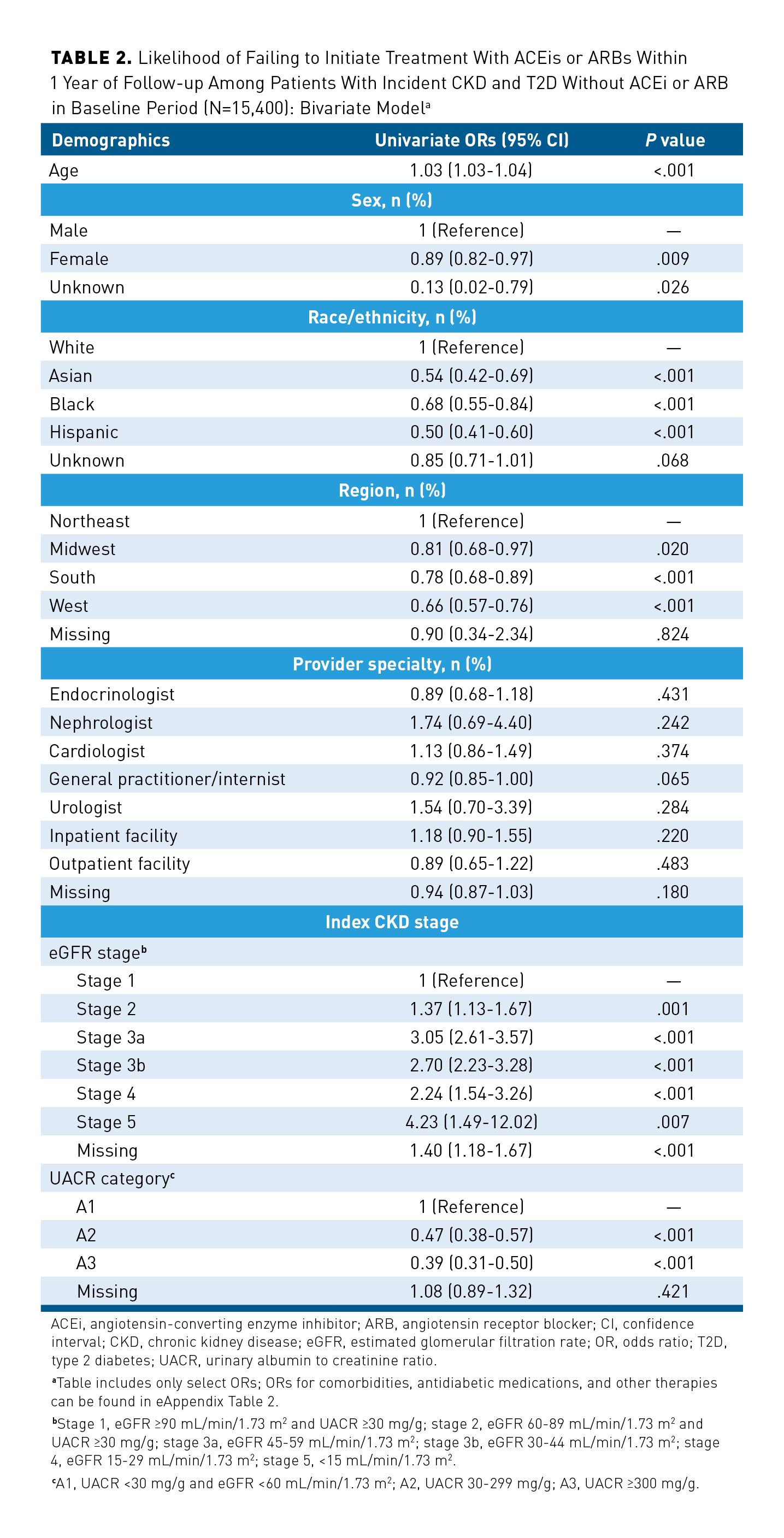
Discussion
This study described characteristics associated with initiation of treatment with ACEis or ARBs within 1 year after meeting the criteria for CKD among patients with T2D. Approximately two-thirds of newly identified patients with CKD were already receiving ACEis or ARBs at the time of diagnosis; of the remaining one-third, only 17% of patients initiated therapy within 1 year, despite a similarly high prevalence of hypertension in that group. It is possible that some patients did not initiate these therapies due to use of other medications, in particular those with resistant hypertension, which was associated with a lower likelihood of beginning ACEi or ARB therapy. In our analysis, patients who did not initiate ACEis or ARBs within follow-up were more likely to be White; reside in the northeastern United States; have normal to mildly increased persistent albuminuria (UACR category A1); have a higher number of comorbidities, including atrial fibrillation, coronary artery disease, depression, pain disorders, and resistant hypertension; and have a prescription for SGLT2is.
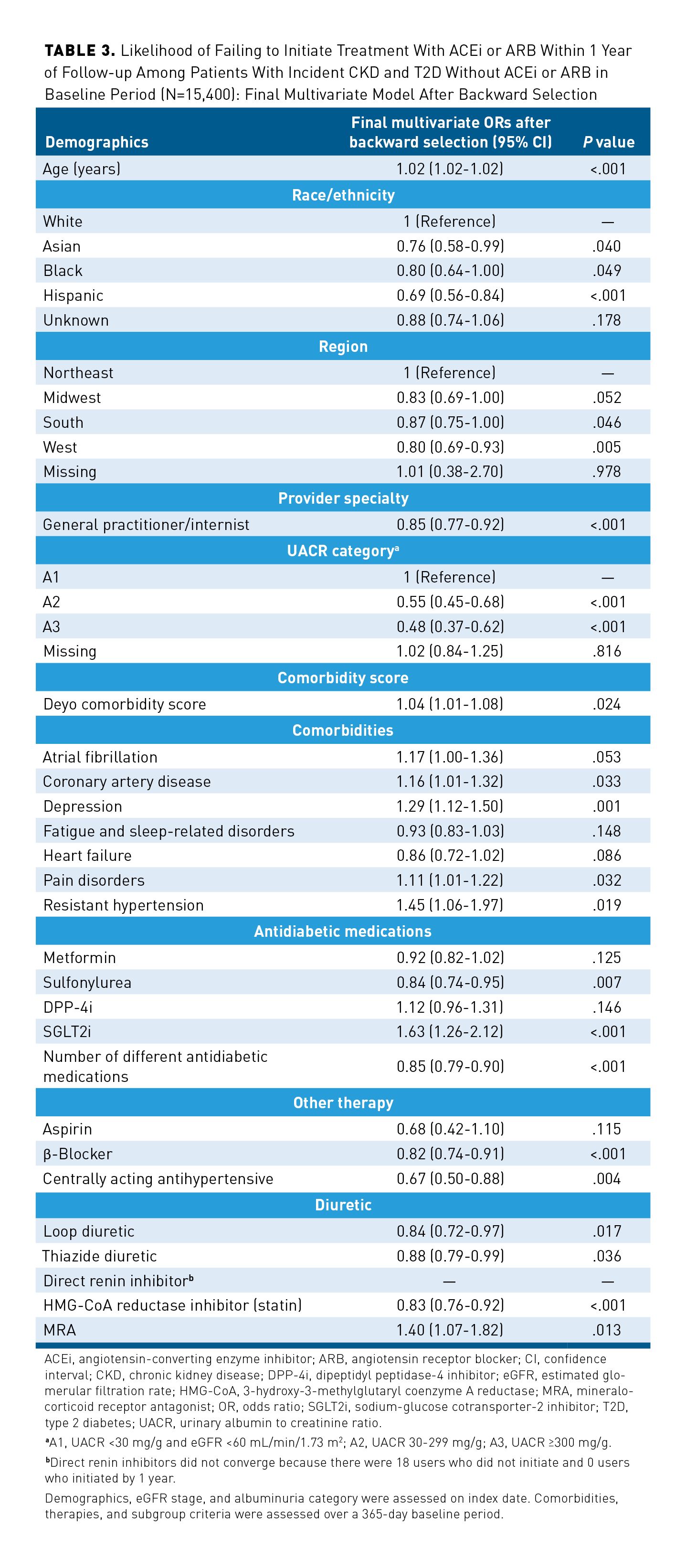
Based on published literature suggesting safety issues as a barrier to ACEi or ARB treatment initiation, we considered the presence of relative contraindications to ACEi or ARB therapy (eg, hyperkalemia, hypotension)21-25; however, the similar prevalence of contraindications among initiates and noninitiates suggests that contraindications alone may not explain the failure to initiate ACEis or ARBs in our study population.
Although advanced eGFR stage at the time of patient identification was associated with a lower likelihood of treatment initiation with ACEis or ARBs in the bivariate model, this association did not persist in the final model. However, we observed an association with UACR category, suggesting that UACR category A1 was associated with failure to initiate treatment within 1 year of follow-up. This incongruity may reflect the differing medical evidence regarding treatment to reduce eGFR compared with proteinuria. The guidelines from Kidney Disease: Improving Global Outcomes recommend that ACEis or ARBs be titrated to the highest approved dose that is tolerated regardless of albuminuria level, whereas published results from the Reduction of Endpoints in NIDDM with the Angiotensin II Antagonist Losartan (RENAAL) study and the Irbesartan Diabetic Nephropathy Trial (IDNT) emphasize the benefits of ACEi or ARB therapy in patients with severely increased albuminuria.11,13,26 ACEi therapy is often not started in patients with advanced CKD, but these individuals may derive the greatest benefit.12 In the RENAAL study and IDNT, patients were initiated on ARB therapy when their creatinine levels reached 3.0 mg/dL, and the medication was continued despite rising creatinine values.11,13 These varying medical opinions on the use of ACEis or ARBs in advanced CKD may affect prescribing patterns.
In addition, our final multivariate predictive model showed that while sulfonylurea use was associated with ACEi or ARB treatment, SGLT2i use was associated with a lower likelihood of ACEi or ARB treatment initiation within 1 year of meeting CKD criteria. However, it should be noted that this study included a small number of patients taking SGLT2 is (n= 455). The association of SGLT2i use and failure to initiate ACEi or ARB therapy most likely reflects the burgeoning evidence of the renal-protective effects of this second-line antidiabetic treatment on kidney disease progression27,28 and the likely choice of SGLT2is to provide renal-protective benefits in patients who cannot take ACEis or ARBs. The association of the use of other cardiovascular agents with ACEi or ARB initiation—except for MRAs—aligns with the addition of ACEis or ARBs to prior antihypertensive therapies, or treatment augmentation, for better blood pressure control.
Several published studies also highlight suboptimal prescribing of ACEis or ARBs in high-risk patients with diabetes when evaluating real-world determinants of ACEi or ARB utilization. Among Medicare Part D enrollees, 43.1% of patients with diabetes and renal disease used ACEis or ARBs; the percentage increased to 63.0% in patients with diabetes, renal disease, and hypertension.29 Patient characteristics associated with ACEi or ARB use in this Medicare D population were female sex, non-White race, age at least 65 years, and specific comorbidities (eg, hypercholesterolemia, heart failure, and myocardial infarction), which correspond closely to predictors identified in this study. While these studies found that non-White race predicted ACEi or ARB use, a 2004 study of Kaiser Permanente Northern California Diabetes Registry data found similar levels of ACEi or ARB utilization in Black and White patients with T2D (63% vs 61%, respectively). However, Black patients with T2D with albuminuria had significantly lower ACEi/ARB use than their White counterparts (47% vs 56%, respectively).30 The lack of pronounced racial disparity with respect to ACEi or ARB therapy in our analysis and the Medicare D analysis may be due to a greater awareness of high-risk ethnic groups among physicians.
Differing from the Medicare D analysis, none of the individual comorbidities in our analysis predicted ACEi or ARB use after CKD diagnosis among patients with T2D without evidence of ACEi or ARB use during baseline. Heart failure was suggestive of an association (odds ratio, 0.86; 95% CI, 0.72-1.02) but it was not significant in the final model; moreover, several individual comorbidities (ie, coronary artery disease, depression, atrial fibrillation, pain disorders, and resistant hypertension) were associated with a lower likelihood of ACEi or ARB treatment initiation in our analysis. The final model showed that the use of several cardiovascular-related medications (eg, β-blockers, centrally active antihypertensives, diuretics, and statins) was associated with a higher likelihood of ACEi or ARB treatment initiation.
Limitations
This study had several limitations. First, laboratory results in administrative claims data were incomplete and available for only a subset of patients who received testing at a participating laboratory. Laboratory results that were performed in a hospital setting or directly at the physician’s office are most likely underrepresented. Laboratory participation was assumed to be random; thus, selection bias was not a concern. Second, we refer to eGFR and UACR laboratory results as the gold standard for the identification of renal disease. However, there are circumstances in which any creatinine-based estimate of kidney function, including eGFR, should not be used; thus, some patients may have been misclassified. For example, creatinine-based estimates should be avoided in patients in the following circumstances: people with changing serum creatinine levels; people with acute kidney injury; those with extremes in muscle mass, body size, or altered diets; and individuals taking medications that affect excretion of creatinine. Third, the logistic regression model attempted to relate potential predictors to the likelihood of ACEi or ARB initiation. To this end, we cannot rule out the possibility of unmeasured confounding of the estimated associations or unmeasured predictors of differential dropout, which may bias our estimates. Fourth, the study included patients without albuminuria and/ or hypertension for whom ACEi or ARB therapy is not indicated according to current guidelines. However, the proportion of such patients was assumed to be low, because 80.1% of noninitiates had a diagnosis for hypertension and approximately 81.4% had a diagnosis for albuminuria (assuming that the distribution is the same in those with missing information for UACR). Finally, the study required patients to have continuous enrollment in their health plan for a fixed follow-up time, potentially introducing selection bias by excluding patients who did not survive or were not enrolled for a minimum period of follow-up.
Conclusions
This study estimated that one-third of patients with T2D are not receiving ACEis or ARBs at the time of newly diagnosed CKD, and a large proportion of them do not initiate the guideline-recommended ACEi or ARB therapy within 1 year of diagnosis. Characteristics associated with a lower likelihood of ACEi or ARB initiation among nonusers include less advanced albuminuria, use of MRAs and SGLT2is, and comorbid conditions such as coronary artery disease, depression, and resistant hypertension. Given that failure to initiate treatment in these patients may adversely affect disease progression, these findings highlight the need for new therapies that can slow the progression of newly diagnosed CKD in T2D. Future research to better understand the impact of this treatment delay on patient outcomes and the reasons for not receiving ACEis or ARBs as indicated by guidelines will benefit a growing population of patients with newly diagnosed CKD in T2D who have a demonstrated unmet need.
Author affiliations: Bayer AG, Wuppertal, Germany (KF); University of Pittsburgh School of Medicine, Pittsburgh, PA (LFF); University of Tennessee Health Science Center, Memphis, TN (CPK); Aetion, Boston, MA (NP-I); Bayer AG, Berlin, Germany (NS); IQVIA Inc, Cambridge, MA (PV).
Funding source: This supplement was supported by Bayer AG.
Author disclosures: Ms Folkerts and Dr Schmedt have been employees of the sponsor of the study, Bayer AG, and have disclosed that a Bayer Pharmaceuticals drug for chronic kidney disease in patients with type 2 diabetes is approved in the United States. Ms Folkerts has also owned stock in Bayer AG, sponsor of the study. Dr Fried has served as a consultant to Bayer Pharmaceuticals. Dr Kovesdy has served as a consultant and has received honoraria for consultancy work with AstraZeneca and Bayer Pharmaceuticals. Dr Petruski-Ivleva has reported no relationships or financial interests with any entity that would pose a conflict of interest with the subject matter of this supplement. Dr Velentgas has been an employee of IQVIA, which conducts research for all of the world’s biopharmaceutical companies.
Authorship information: Concept and design (LFF, CPK, NP-I, PV); analysis and interpretation of data (KF, CPK, NP-I, NS, PV); drafting of the manuscript (KF, NP-I, NS); critical revision of the manuscript for important intellectual content (KF, LFF, CPK, NP-I, NS, PV); statistical analysis (NP-I); administrative, technical, or logistic support (NP-I); supervision (NP-I, PV).
Address correspondence to: Csaba P. Kovesdy, MD; ckovesdy@uthsc.edu
REFERENCES
1. Centers for Disease Control and Prevention. National Diabetes Statistics Report, 2017. Estimates of diabetes and its burden in the United States. 2017. Accessed August 31, 2021. https://dev.diabetes.org/ sites/default/files/2019-06/cdc-statistics-report-2017.pdf
2. Macisaac RJ, Ekinci EI, Jerums G. Markers of and risk factors for the development and progression of diabetic kidney disease. Am J Kidney Dis. 2014;63(suppl 2):S39-S62. doi:10.1053/j.ajkd.2013.10.048
3. American Diabetes Association. 8. Cardiovascular Disease and Risk Management. Diabetes Care. 2016;39(suppl 1):S60-S71. doi:10.2337/dc16-S011
4. Afkarian M, Sachs MC, Kestenbaum B, et al. Kidney disease and increased mortality risk in type 2 diabetes. J Am Soc Nephrol. 2013;24(2):302-308. doi:10.1681/ASN.2012070718
5. Ayodele OE, Alebiosu CO, Salako BL. Diabetic nephropathy—a review of the natural history, burden, risk factors and treatment. J Natl Med Assoc. 2004;96(11):1445-1454.
6. Saran R, Robinson B, Abbott KC, et al. US Renal Data System 2017 Annual Data Report: Epidemiology of Kidney Disease in the United States. Am J Kidney Dis. 2018;71(suppl 1):A7. doi:10.1053/j.ajkd.2018.01.002
7. American Diabetes Association. 11. Microvascular complications and foot care: Standards of Medical Care in Diabetes-2019. Diabetes Care. 2019;42(suppl 1):S124-S138. doi:10.2337/dc19-S011
8. Introduction: Standards of Medical Care in Diabetes-2019. Diabetes Care. 2019;42(suppl 1):S1-S2. doi:10.2337/dc19-Sint01
9. Sun JW, Rogers JR, Her Q, et al. Adaptation and validation of the combined comorbidity score for ICD10-CM. Med Care. 2017;55(12):1046-1051. doi:10.1097/MLR.0000000000000824
10.Dojki FK, Bakris G. Nonsteroidal mineralocorticoid antagonists in diabetic kidney disease. Curr Opin Nephrol Hypertens. 2017;26(5):368-374. doi:10.1097/MNH.0000000000000340
11.Brenner BM, Cooper ME, de Zeeuw D, et al; RENAAL Study Investigators. Effects of losartan on renal and cardiovascular outcomes in patients with type 2 diabetes and nephropathy. N Engl J Med. 2001;345(12):861-869. doi:10.1056/NEJMoa011161
12.Lewis EJ, Hunsicker LG, Bain RP, Rohde RD; The Collaborative Study Group. The effect of angiotensin-converting-enzyme inhibition on diabetic nephropathy. N Engl J Med. 1993;329(20):1456-1462. doi:10.1056/NEJM199311113292004
13.Lewis EJ, Hunsicker LG, Clarke WR, et al; Collaborative Study Group. Renoprotective effect of the angiotensin-receptor antagonist irbesartan in patients with nephropathy due to type 2 diabetes. N Engl J Med. 2001;345(12):851-860. doi:10.1056/NEJMoa011303
14.Ravid M, Lang R, Rachmani R, Lishner M. Long-term renoprotective effect of angiotensin-converting enzyme inhibition in non-insulin-dependent diabetes mellitus. a 7-year follow-up study. Arch Intern Med. 1996;156(3):286-289.
15.Seidu S, Kunutsor SK, Cos X, Gillani S, Khunti K; for and on behalf of Primary Care Diabetes Europe. SGLT2 inhibitors and renal outcomes in type 2 diabetes with or without renal impairment: a systematic review and meta-analysis. Prim Care Diabetes. 2018;12(3):265-283. doi:10.1016/j.pcd.2018.02.001
16.National Kidney Foundation. KDOQI clinical practice guideline for diabetes and CKD: 2012 update. Am J Kidney Dis. 2012;60(5):850-886. doi:10.1053/j.ajkd.2012.07.005
17.Optum. Retrospective database analysis. 2013. Accessed August 31, 2021. https://www.optum.com/ content/dam/optum/resources/productSheets/Retrospective-Database-Analysis.pdf
18.Miller DR, Safford MM, Pogach LM. Who has diabetes? Best estimates of diabetes prevalence in the Department of Veterans Affairs based on computerized patient data. Diabetes Care. 2004;27(suppl 2):B10- B21. doi:10.2337/diacare.27.suppl_2.B10
19.Lindsey C, Sheather S. Variable selection in linear regression. Stata J. 2010;10(4):650-669.
20.Wang SV, Verpillat P, Rassen JA, Patrick A, Garry EM, Bartels DB. Transparency and reproducibility of observational cohort studies using large healthcare databases. Clin Pharmacol Ther. 2016;99(3):325-332. doi:10.1002/cpt.329
21.Molnar MZ, Kalantar-Zadeh K, Lott EH, et al. Angiotensin-converting enzyme inhibitor, angiotensin receptor blocker use, and mortality in patients with chronic kidney disease. J Am Coll Cardiol. 2014;63(7):650-658. doi:10.1016/j.jacc.2013.10.050
22.Fried LF, Emanuele N, Zhang JH, et al; VA NEPHRON-D Investigators. Combined angiotensin inhibition for the treatment of diabetic nephropathy. New Engl J Med. 2013;369(20):1892-1903. doi:10.1056/NEJMoa1303154
23.Yildirim T, Arici M, Piskinpasa S, et al. Major barriers against renin-angiotensin-aldosterone system blocker use in chronic kidney disease stages 3-5 in clinical practice: a safety concern? Ren Fail. 2012;34(9):1095-1099. doi:10.3109/0886022X.2012.717478
24.Vijayakumar S, Butler J, Bakris GL. Barriers to guideline mandated renin-angiotensin inhibitor use: focus on hyperkalaemia. Eur Heart J Suppl. 2019; 21(suppl A):A20-A27. doi:10.1093/eurheartj/suy030
25.Winkelmayer WC, Fischer MA, Schneeweiss S, Wang PS, Levin R, Avorn J. Underuse of ACE inhibitors and angiotensin II receptor blockers in elderly patients with diabetes. Am J Kidney Dis. 2005;46(6):1080- 1087. doi:10.1053/j.ajkd.2005.08.018
26.de Boer IH, Caramori ML, Chan JCN, et al; Kidney Disease: Improving Global Outcomes (KDIGO) Working Group. KDIGO 2020 Clinical Practice Guideline for Diabetes Management in Chronic Kidney Disease. Kidney Int. 2020;98(suppl):S1-S115. doi:10.1016/j.kint.2020.06.019
27.Neuen BL, Young T, Heerspink HJL, et al. SGLT2 inhibitors for the prevention of kidney failure in patients with type 2 diabetes: a systematic review and meta-analysis. Lancet Diabetes Endocrinol. 2019;7(11):845-854. doi:10.1016/S2213- 8587(19)30256-6
28.Fioretto P, Zambon A, Rossato M, Busetto L, Vettor R. SGLT2 inhibitors and the diabetic kidney. Diabetes Care. 2016;39(suppl 2):S165-S171. doi:10.2337/dcS15-300
29.Yang Y, Thumula V, Pace PF, Banahan BF III, Wilkin NE, Lobb WB. High-risk diabetic patients in Medicare Part D programs: are they getting the recommended ACEI/ARB therapy? J Gen Intern Med. 2010; 25(4):298-304. doi:10.1007/s11606-009-1242-z
30.Rosen AB, Karter AJ, Liu JY, Selby JV, Schneider EC. Use of angiotensin-converting enzyme inhibitors and angiotensin receptor blockers in high-risk clinical and ethnic groups with diabetes. J Gen Intern Med. 2004;19(6):669-675. doi:10.1111/j.1525-1497.2004.30264.x

